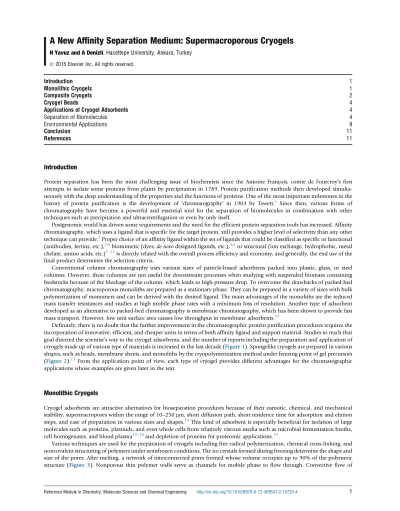A New Affinity Separation Medium: Supermacroporous Cryogels
Protein separation has been the most challenging issue of biochemists since the Antoine Franc ̧ois, comte de Fourcroy’s first attempts to isolate some proteins from plants by precipitation in 1789. Protein purification methods then developed simulta- neously with the deep understanding of the properties and the functions of proteins. One of the most important milestones in the history of protein purification is the development of ‘chromatography’ in 1903 by Tswett.1 Since then, various forms of chromatography have become a powerful and essential tool for the separation of biomolecules in combination with other techniques such as precipitation and ultracentrifugation or even by only itself.
Postgenomic world has driven some requirements and the need for the efficient protein separation tools has increased. Affinity chromatography, which uses a ligand that is specific for the target protein, still provides a higher level of selectivity than any other technique can provide.2 Proper choice of an affinity ligand within the set of ligands that could be classified as specific or functional (antibodies, lectins, etc.),3,4 biomimetic (dyes, de novo designed ligands, etc.),5,6 or structural (ion exchange, hydrophobic, metal chelate, amino acids, etc.)7–11 is directly related with the overall process efficiency and economy, and generally, the end use of the final product determines the selection criteria.
Conventional column chromatography uses various sizes of particle-based adsorbents packed into plastic, glass, or steel columns. However, these columns are not useful for downstream processes when studying with suspended biomass containing feedstocks because of the blockage of the column, which leads to high-pressure drop. To overcome the drawbacks of packed-bed chromatography, macroporous monoliths are prepared as a stationary phase. They can be prepared in a variety of sizes with bulk polymerization of monomers and can be derived with the desired ligand. The main advantages of the monoliths are the reduced mass transfer resistances and studies at high mobile phase rates with a minimum loss of resolution. Another type of adsorbent developed as an alternative to packed-bed chromatography is membrane chromatography, which has been shown to provide fast mass transport. However, low unit surface area causes low throughput in membrane adsorbents.12
Definitely, there is no doubt that the further improvement in the chromatographic protein purification procedures requires the incorporation of innovative, efficient, and cheaper units in terms of both affinity ligand and support material. Studies to reach that goal directed the scientist’s way to the cryogel adsorbents, and the number of reports including the preparation and application of cryogels made up of various type of materials is increased in the last decade (Figure 1). Spongelike cryogels are prepared in various shapes, such as beads, membrane sheets, and monoliths by the cryopolymerization method under freezing point of gel precursors (Figure 2).13 From the application point of view, each type of cryogel provides different advantages for the chromatographic applications whose examples are given later in the text.
